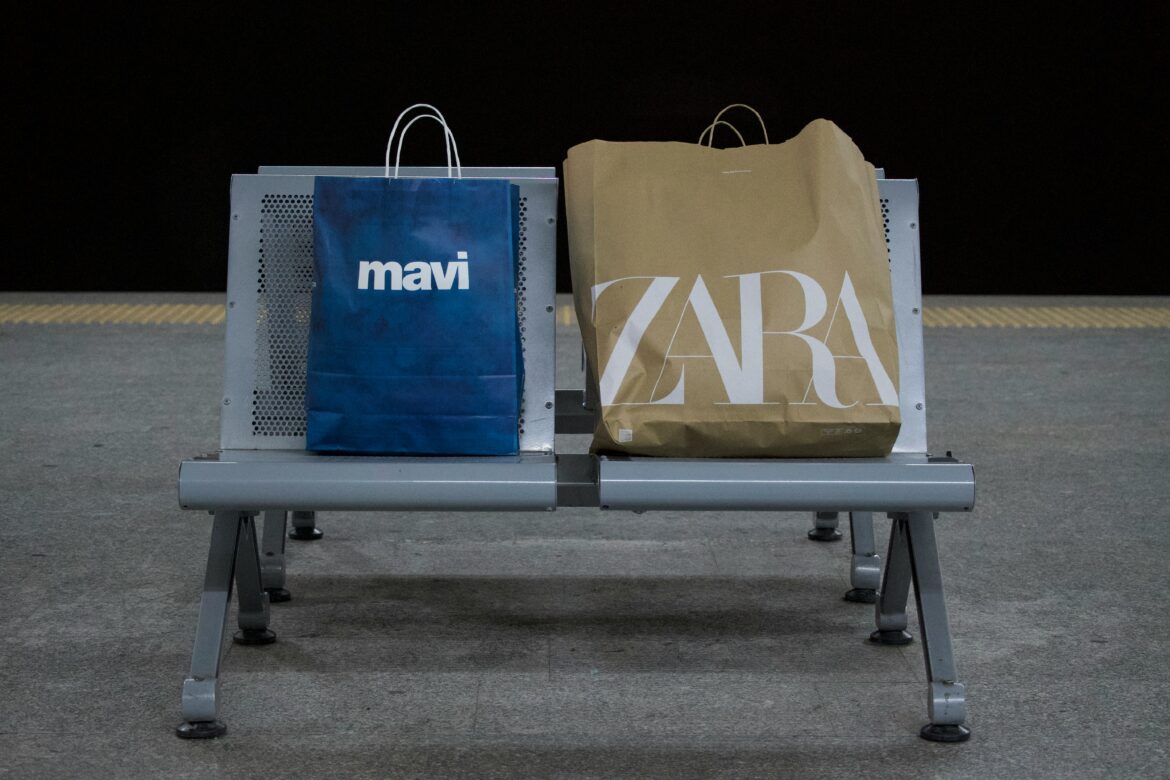So, what’s next for fashion e-commerce? For 2025, the answer is about individual experiences and a more intelligent shopping process. And we can bet you have heard this before.
The competition is fierce, and brands just must adapt quickly with these smart strategies. Social commerce? Bigger than ever. Personalization? Smarter than before. Resale fashion? Booming.
If you’re in fashion e-commerce, now’s the time to get ahead. Let’s explore what’s shaping the future of online fashion, or check out the ChannelEngine report here.
The evolution of fashion
Fashion, as we know it, has undergone a remarkable transformation over the years. From the early days of handcrafted garments to today’s tech-driven industry, the evolution is nothing short of fascinating. In 2021, the global apparel and footwear market was valued at a little above $1.71 trillion, in 2025 – according to McKinsey & Company’s “State of Fashion 2025” report, the global fashion market is valued at approximately $2.5 trillion.
However, only 20% of fashion executives anticipate an improvement in consumer sentiment this year, while 39% foresee a decline, reflecting a cautious outlook within the industry.
E-commerce continues to be a significant driver of growth. Statista projects that the online fashion market will reach $880.90 billion in revenue by the end of 2025, and hit even $1,182.70 billion in 2029. User penetration is anticipated to hit 34.4% in 2025, increasing to 37.8% by 2029.
Despite these growth prospects, the industry faces challenges.
Major retailers like Primark have adjusted their sales forecasts due to subdued consumer spending in key markets such as the UK. Primark reported a 6% decline in like-for-like sales in the UK and Ireland. It attributes this to cautious consumer behavior and unseasonably mild weather affecting demand for seasonal apparel.
Germany: A rising hub for fashion e-commerce
Germany is solidifying its position as a powerhouse in fashion e-commerce in 2025. The country’s e-commerce revenue is projected to reach $116 billion this year, approaching the pandemic peak of 2021, which stood at $121 billion.
Fashion remains a dominant force in this landscape. A recent survey revealed that 99% of German adults now shop online, with 39% making purchases at least once a week. Notably, fashion items are the most popular, with two-thirds of respondents ordering clothing and shoes online in the past year. One of the companies leading the charge is Berlin-based Zalando, which has seen its active customer base soar to over 50 million in only 2022 year. This growth highlights the increasing preference for online fashion shopping among Germans.
Looking ahead, the fashion e-commerce market in Germany is expected to continue its upward trajectory, with revenues projected to increase by approximately 47.81% between 2024 and 2029, reaching a new peak of $32.73 billion.
But how is this possible? Well, this surge is fueled by several factors:
- High internet penetration. Germany boasts many, really many internet users (77.70 million at the beginning of 2024), and they facilitate widespread access to online shopping platforms.
- Efficient logistics. The country’s advanced logistics infrastructure ensures timely and reliable delivery of online purchases.
- Online payments. German consumers have a high level of trust in online payment systems and data security, encouraging more frequent online transactions.
As you can see, Germany’s combination of technological infrastructure, consumer behavior, and market dynamics is propelling it to the forefront of fashion e-commerce in 2025.
Top fashion e-commerce trends for 2025
All right, let’s get down to the main act.
Now we will present you 8 top fashion for 2025. These trends represent the most transformative and impactful aspects of fashion e-commerce this year. Some of them are well-known, some are more surprising.
Let’s see the whole list and prepare for the future!
1. Personalization at scale
Consumers expect more than just a standard shopping experience. They want to feel seen and understood. And that’s exactly where personalization with big data and AI comes in.
Think about it: platforms like Zara analyze browsing and purchase history to tailor product recommendations, both online and in stores. It’s a strategy that turns casual browsers into loyal customers. Meanwhile, ASOS is redefining website engagement with dynamic content. If you’re searching for formalwear, their site adapts to show you exactly what you’re after. Clever, right?
Amazon takes it even further with recommendation engines. These algorithms dive into your activity, suggesting items that match your style. It’s no wonder they’ve become a leader in personalized e-commerce.
And let’s not forget Urban Outfitters’ genius use of user-generated content. They feature real customers showing off their purchases, creating a sense of community and authenticity.
So, in quick points, here’s why personalization still works:
- Because engagement skyrockets – people talk better about your brand, as the shopping experience feels tailored.
- Because loyalty deepens – customers stick with brands that “get them.”
- Because sales increase – with personalization, people are eager to buy things they were looking for. It feels like a win-win.
With personalization, the future of fashion is about making connections that matter.
2. The rise of re-ecommerce fashion
Sustainability is growing faster than ever. Did you know the global secondhand apparel market is projected to reach $350 billion by 2028? Yes, it’s true! That’s because more consumers are rethinking how they shop and choosing options that align with their values.
Take platforms like Vinted and Depop. These marketplaces make it ridiculously easy to buy and sell secondhand items. In Europe, millions are embracing this trend, downloading apps and listing their pre-loved pieces. It’s not just convenient—it’s changing the way we think about consumption.
And brands are catching on. Circular economy models are gaining traction, encouraging customers to recycle or resell items instead of throwing them away. This shift benefits everyone:
- The planet. Less waste means a smaller environmental footprint.
- Brands. Sustainability builds trust and attracts eco-conscious consumers.
- Shoppers. Affordable, guilt-free fashion is now at their fingertips.
It’s not just resale that’s driving this change. Companies are rethinking their production models, too, prioritizing ethical labor and environmentally friendly materials. After all, who doesn’t want fashion that looks good and does good?
Sustainable fashion is here to stay, and it’s reshaping the industry—one conscious choice at a time.
3. Social commerce takes center stage
Have you ever bought something directly from a social media app? Positive? Well, you’re not alone.
Social commerce is booming – the predictions said it will reach $1.2 trillion by 2025. And platforms like TikTok, Instagram, and Pinterest are leading the charge. Why?
Because they blur the line between scrolling and shopping, making impulse buys easier than ever.
Take TikTok, for example. Brands like Zara and H&M are leveraging its shoppable features to showcase collections in real-time. And it works! TikTok’s ability to engage users with short, compelling videos has revolutionized how we discover fashion.
Instagram is no slouch, either. With Instagram Shopping, customers can browse, compare, and buy without leaving the app. It’s seamless, convenient, and perfect for today’s busy shoppers.
But it’s not just about platforms but about people.
Influencers play a massive role in social commerce, providing authentic recommendations that resonate deeply with their followers. And let’s not forget user-generated content! When customers share photos of their favorite purchases, it inspires others to shop, creating a cycle of engagement and trust.
4. Omnichannel shopping experiences
Shopping these days goes beyond a single app. Nor are they limited to one shop or social media platform. When it comes to shopping nowadays, it makes sense to connect your points of sale and make it easy for customers to buy across many channels, without interrupting the process.
That’s the beauty of omnichannel retail.
By integrating online stores, apps, and physical locations, brands create a seamless experience that meets customers wherever they are.
Take ASOS as an example. This powerhouse ensures customers have consistent access to products, whether they’re on the website, mobile app, or exploring partner stores. Nordstrom takes it a step further with a loyalty program that rewards customers regardless of the channel they use.
But why does this matter so much? Because consumers demand convenience. And a unified shopping experience means:
- Browsing online and picking up in-store.
- Trying items in-store and ordering later from an app.
- Getting personalized offers across platforms.
And let’s not forget marketplaces. Amazon, Zalando, and others make omnichannel strategies even more powerful by offering brands access to massive audiences. For smaller brands, these platforms lower the barrier to entry while still delivering big results.
5. AR and virtual try-ons revolutionizing shopping
AR technology is one of the most innovative tools in fashion e-commerce. Its ability to reduce returns, enhance personalization, and increase customer satisfaction is strongly emphasized.
Imagine shopping for a dress and being able to try it on without even leaving your house. Well, it’s already happening. Again, brands like Zalando have embraced AR-powered virtual try-ons, using advanced 3D avatars to help customers visualize garments with accuracy. And the results? Happier customers and boosted sales.
So, to conclude, AR adoption is growing because it solves two key problems in fashion e-commerce:
- Enhance confidence in purchases – shoppers are more likely to click “buy” when they can see how an item fits or looks.
- Reduce returns – fewer “it didn’t fit” scenarios mean lower costs for brands and less environmental waste.
💡 AR tools also generate valuable data about customer preferences. Your brand can use this information to refine inventory strategies and offer more targeted recommendations.
6. Flexible payment solutions transforming checkout
Flexible payment solutions are driving the future of e-commerce, and fashion brands are cashing in. From Buy Now, Pay Later (BNPL) to cryptocurrencies, customers now have more ways to pay than ever before.
Take BNPL, for instance. Services like Klarna and Affirm allow shoppers to split payments into manageable chunks. It’s a game-changer that reduces cart abandonment and makes fashion more accessible. Frasers Group even integrated BNPL into its platform, showing just how essential this option has become.
And let’s talk mobile wallets. Apple Pay, Google Pay, and PayPal have soared in popularity, especially in markets like India, where 90% of consumers prefer digital wallets. Secure, fast, and convenient, these options cater to today’s on-the-go shoppers.
What about cryptocurrency? Well, luxury brands like Gucci and Balenciaga are already accepting digital currencies, appealing to tech-forward customers who want alternative payment methods.
7. Marketplaces as growth drivers
When it comes to fashion e-commerce, marketplaces are the unsung heroes. They offer unparalleled reach, easy scalability, and ready-made infrastructure. And the numbers speak for themselves: Amazon reported revenues of $158.9 billion in 2024, with third-party vendors driving much of that success.
But Amazon isn’t alone. Zalando, operating across 25 European countries, hit €10.5 billion in revenue in 2024, thanks to its millions of active customers. These platforms create opportunities for brands of all sizes to reach global audiences without the headaches of building standalone stores.
Why are marketplaces so powerful?
- Lower entry barriers. Brands don’t need to invest heavily in infrastructure.
- Global expansion. Platforms like Asos ship to all 196 countries using efficient fulfillment networks.
- Consumer trust. Established marketplaces come with built-in credibility, robust buyer protection policies, and user reviews.
8. Subscription models in fashion
Want to never run out of your favorite wardrobe essentials or discover curated styles monthly? Subscription models can guarantee you that. From Fabletics’ personalized activewear boxes to Rent the Runway’s designer rentals, subscriptions are redefining convenience.
Why are they so popular? It’s simple:
- Predictable revenue – brands enjoy steady income streams, making planning easier.
- Customer loyalty – subscribers are less likely to shop elsewhere when they’re locked into a recurring service.
- Personalization – data collected through subscriptions helps brands refine offerings.
Whether it’s premium items made affordable through rentals or monthly surprise boxes, the appeal is undeniable.
And every purchase, preference, and feedback loop fuels smarter recommendations and better experiences. Take Fabletics, for example. They use data from subscribers to improve fit, style options, and overall satisfaction. This approach keeps customers coming back for more.
So, are subscriptions the future of fashion?
Well, with their ability to balance convenience and personalization, it’s clear they’re here to stay.
Take the next step!
The fashion industry in 2025 is characterized by cautious optimism, with growth opportunities tempered by economic uncertainties and evolving consumer expectations.
Brands that adapt to these dynamics by embracing re-ecommerce, social commerce, technological innovations, consumer-centric strategies, subscription models, the most popular payment methods, and many, many other micro trends.
And what about you? Is your business ready to take part in fashion trends in 2025?
***




